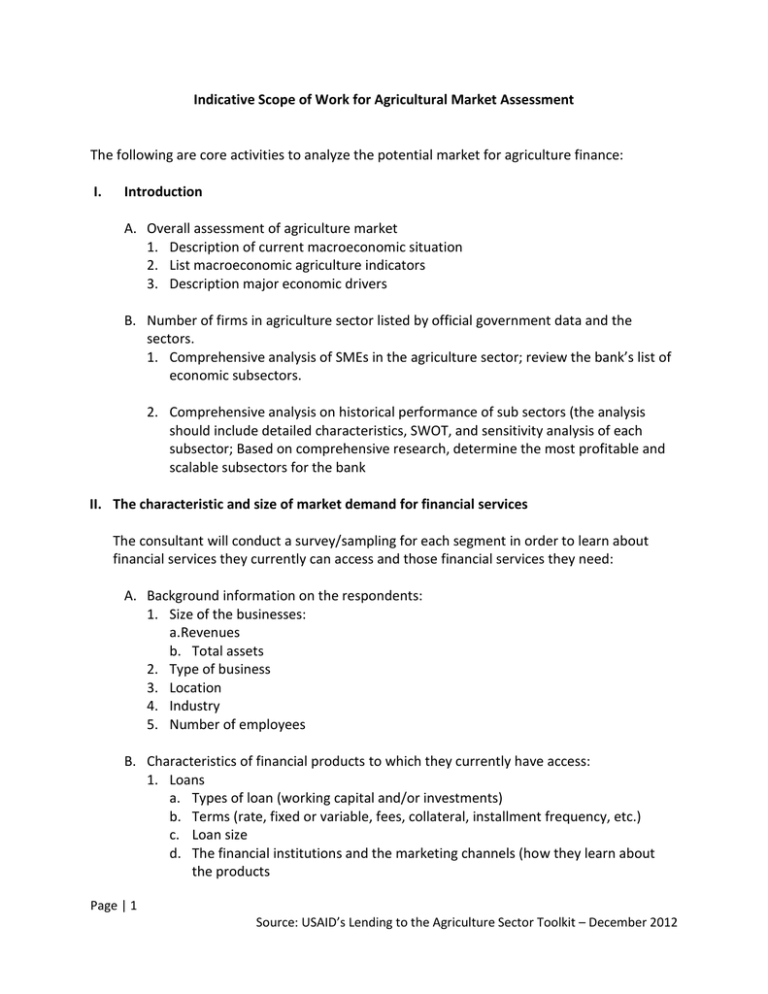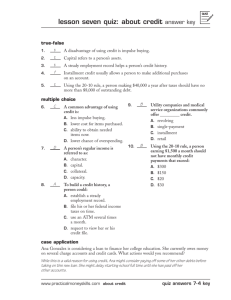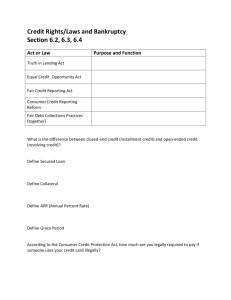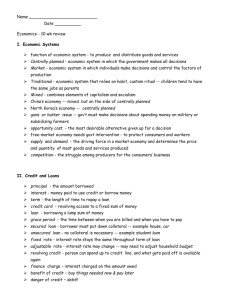English (DOC) - Agriculture Finance Support Facility
advertisement

Indicative Scope of Work for Agricultural Market Assessment The following are core activities to analyze the potential market for agriculture finance: I. Introduction A. Overall assessment of agriculture market 1. Description of current macroeconomic situation 2. List macroeconomic agriculture indicators 3. Description major economic drivers B. Number of firms in agriculture sector listed by official government data and the sectors. 1. Comprehensive analysis of SMEs in the agriculture sector; review the bank’s list of economic subsectors. 2. Comprehensive analysis on historical performance of sub sectors (the analysis should include detailed characteristics, SWOT, and sensitivity analysis of each subsector; Based on comprehensive research, determine the most profitable and scalable subsectors for the bank II. The characteristic and size of market demand for financial services The consultant will conduct a survey/sampling for each segment in order to learn about financial services they currently can access and those financial services they need: A. Background information on the respondents: 1. Size of the businesses: a.Revenues b. Total assets 2. Type of business 3. Location 4. Industry 5. Number of employees B. Characteristics of financial products to which they currently have access: 1. Loans a. Types of loan (working capital and/or investments) b. Terms (rate, fixed or variable, fees, collateral, installment frequency, etc.) c. Loan size d. The financial institutions and the marketing channels (how they learn about the products Page | 1 Source: USAID’s Lending to the Agriculture Sector Toolkit – December 2012 2. Deposits a. Types of deposit b. Average balance c. Average transactions d. Interest rates e. The financial institutions and the marketing channels (how they learn about the products) f. Types of secondary services provided (ATM, debit card, mobile banking, Internet banking, etc.) 3. Other services (including the marketing channels — how they learn about the products) a. Cash management b. Wealth management c. Credit cards d. Payment insurance e. Life insurance f. Informal sources included C. Characteristics of financial products they desire: 1. Loans a. Types of loan (working capital and/or investments) b. Terms (rate, fixed or variable, fees, collateral, installment frequency, etc.) c. Loan size d. Other desired features 2. Deposits a. Types of deposit b. Approximate balance c. Average transactions d. Interest rates e. Other desired features 3. Other services a. Cash management b. Wealth management c. Credit cards d. Payment insurance e. Life insurance f. Informal sources included Page | 2 Source: USAID’s Lending to the Agriculture Sector Toolkit – December 2012 III. Description of existing financial products offered by the bank A. Loans 1. Types of loan (working capital and/or investments) 2. Terms (rate, fixed or variable, fees, collateral, installment frequency, etc.) 3. Loan size 4. Target clientele and the marketing channels B. Deposits 1. Types of deposit 2. Average balance 3. Average transactions 4. Interest rates 5. Types of secondary services provided (ATM, debit card, mobile banking, internet banking, etc.) 6. Target clientele and the marketing channels C. Other services (including target clientele and the marketing channels) 1. Cash management 2. Wealth management 3. Credit cards 4. Payment insurance 5. Life insurance 6. Product bundling 7. Others IV. Summarize gaps between demand and supply, explain findings, and make recommendations A. What is the most profitable and scalable size of businesses? B. What are the most profitable and scalable types of businesses? C. By comparing the results of the market research with the bank’s financial product offerings and existing targeted industry segments, what are the natural areas of overlap? D. What product packages and marketing channels are needed? Page | 3 Source: USAID’s Lending to the Agriculture Sector Toolkit – December 2012






